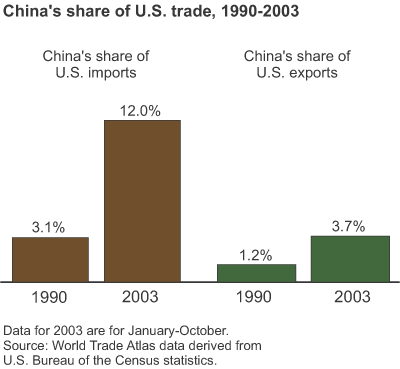Booming China Trade Presents New Challenges for Rural America
- by Fred Gale
- 2/1/2004
The increasing prevalence of 'made in China' labels signals greater competition for many businesses in the rural United States. U.S. imports from China totaled $125.2 billion in 2002, up from $19.3 billion (in constant 2002 dollars) in 1990. Trade with China grew even more in 2003. Preliminary data show that exports and imports had already surpassed their calendar year 2002 totals in the first 10 months of 2003. China's share of U.S. imports rose from 3 percent in 1990 to 12 percent in 2003 (based on January-October totals). Major rural industries, such as apparel, furniture, plastics, and metal products, face direct competition from China. These industries are an important part of the economic base in many rural U.S. communities. However, many other Chinese imports, such as toys and footwear, are displacing imports from other Asian countries; such products are not widely produced in rural America.
China’s economic growth is also also creating business opportunities for U.S. exporters. Between 1990 and 2002, U.S. exports to China grew from just $6 billion to $22 billion (in constant 2002 dollars). Only 3 percent of U.S. exports go to China, but that share has more than doubled since 1990. Dramatic growth in China’s home construction, furniture, communications, automobile, supermarket, restaurant, education, and tourism sectors is increasing China’s demand for imported goods and services. U.S. exports of industrial equipment, electronic components, aircraft, forest products, and animal hides have benefited the most from China’s growth. China has been a boon for U.S. soybean producers, whose sales to China have exceeded $1 billion annually in recent years, accounting for about half of U.S. agricultural exports to China.
Rural U.S. businesses may find many smaller market niches as China grows and opens its retail market to the outside world. U.S. apples, oranges, nuts, wines, cereals, snack foods, meat, and poultry are appearing more often on supermarket shelves and restaurant tables in China. Specialized equipment, machinery, instruments, and technical expertise from the U.S. are in demand as China brings its manufacturing sector up to world standards. Chinese travel overseas is starting to bring extra business to rural U.S. destinations.
China’s exports of basic items like clothing, shoes, toys, and household items benefit consumers in both rural and urban areas by keeping prices low. Additionally, many U.S. businesses benefit from lower costs of imported components, machinery, and equipment.
This article is drawn from:
- China. (n.d.). U.S. Department of Agriculture, Economic Research Service.
- Bowers, D. (2003). Rural America, Vol. 17, Issue 4. U.S. Department of Agriculture, Economic Research Service. RA-174.


